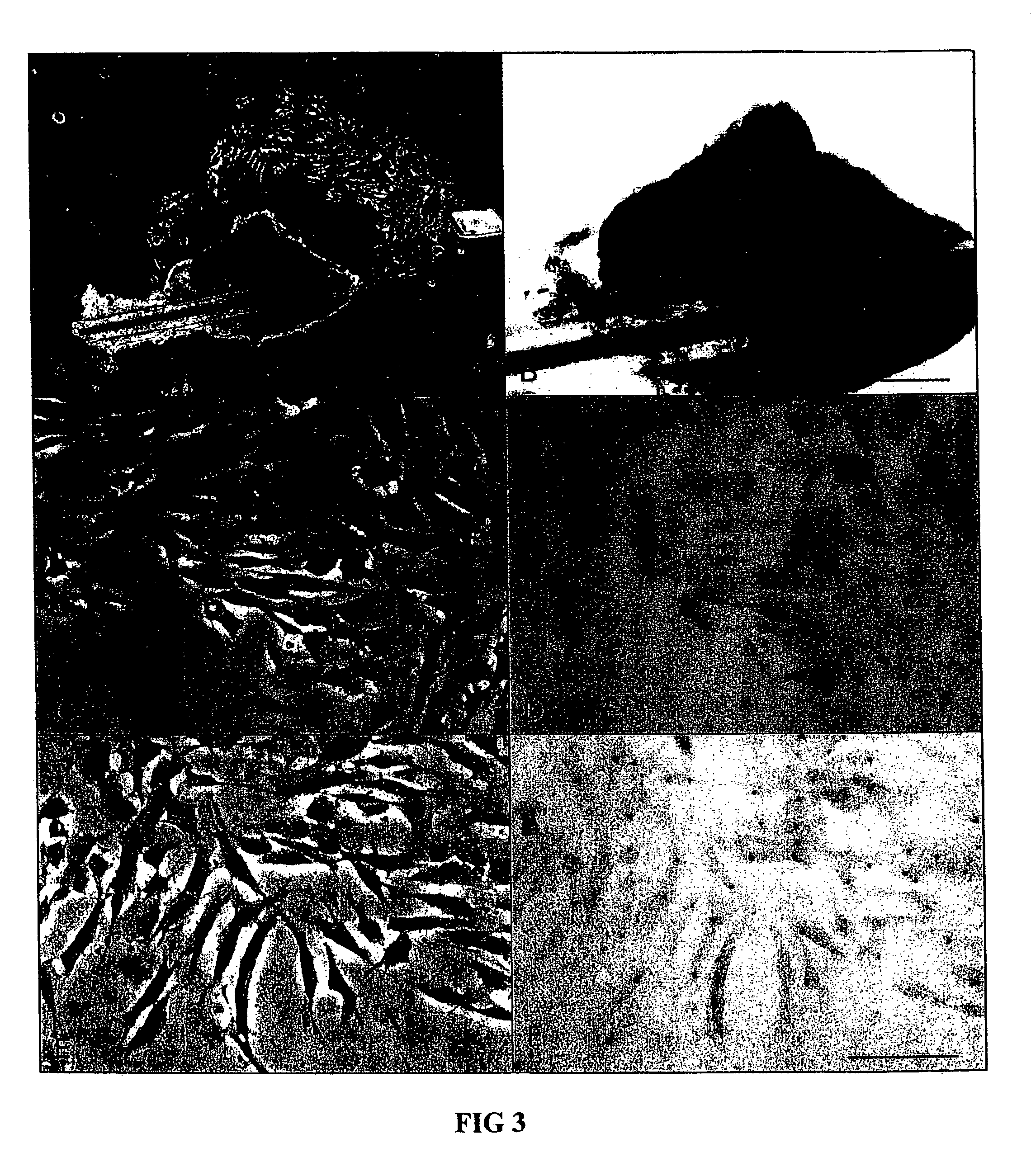Method of isolating epidermal neural crest stem cells
a neural crest stem cell and epidermal technology, applied in the field of isolating epidermal neural crest stem cells, can solve the problems of inability to provide a sufficient amount of neural tissue, inability to use a practical method, and inability to isolate cells from embryonic neural tubes, etc., to achieve the effect of dispersing hair follicles and easy expansion
- Summary
- Abstract
- Description
- Claims
- Application Information
AI Technical Summary
Benefits of technology
Problems solved by technology
Method used
Image
Examples
example 1
Neural Crest-Derived Cells in Hair of Adult Mouse Whiskers
[0070]In this example, we demonstrate that the claimed method can be used to isolate multipotent neural crest stem cells from adult mammalian hair follicles. The following are experimental procedures used in isolating and characterizing a substantially pure population of EPI-NCSCs from bulge region of mouse whiskers as described in Sieber-Blum, M. et al, (2004) Pluripotent Neural Crest Stem Cells in the Adult Hair Follicle, Developmental Dynamics 231:258-269, incorporated by reference here in its entirety. The methods described herein can readily be adapted by one skilled in the art to isolate substantially pure populations of EPI-NCSCs from the hair follicles of other mammals.
Animals and Genotyping
[0071]Heterozygous Wnt1-cre mice were mated with R26R heterozygotes. Genotyping was performed exactly as described (Szeder, V., Grim, M., Halata, Z., and Sieber-Blum, M. (2003) Dev. Biol. 253: 258-263, incorporated by reference her...
example 2
Neural Crest-Derived Cells in Hair of Adult Mouse Back Skin
[0099]In this example, we demonstrate that the claimed method can be used to isolate multipotent neural crest stem cells from different types of hair. This was accomplished as described in M. Sieber-Blum and M. Grim (2004) The Adult Hair Follicle: Cradle for Pluripotent Neural Crest Stem Cells, Birth Defects Research 72:162-172), which is incorporated by reference here in its entirety.
[0100]Specifically, back skin of adult double transgenic mice (Wnt1-cre / R26R) is cut into small pieces (approx. 2×2 mm) and the epidermis is isolated by removing the dermis by collagenase treatment (2 mg / ml Hanks' balanced salt solution, 1 hr at 37° C.), and subsequent three rounds of low speed centrifugation (adapted from Toma et al., 2001 with modifications). Dermal cells remained in the supernatant and were discarded. The pieces of epidermis with attached hair follicles, which pierced the epidermis, were floated outside-up on top of the cult...
example 3
Neural Crest-Derived Cells in Hair of Adult Human Skin
[0103]In this example, we demonstrate that in addition to using the claimed method to isolate neural crest stem cells from mouse (whiskers and back skin hair), the method is easily adapted to and equally applicable to primates, including human hair follicles.
[0104]Specifically, full-thickness skin (scalp and pubic) of a 29 year-old human male was cut into strips (FIG. 15). Collagen fibers were cut and removed with a scalpel, scissors and forceps. Dermal tissue was removed mechanically with bent sharpened tungsten needles, a small scalpel and flushes of Hanks' balanced salt solution. The dissected hair was cut from the epidermis. The dermal papilla was cut and removed and the dissected hair follicles placed into collagen-coated culture plates.
[0105]The culture medium was the same as for mouse neural crest stem cells, consisting of 85% Alpha-modified MEM medium, 5% chick embryo extract and 10% fetal bovine serum. The culture medium...
PUM
| Property | Measurement | Unit |
|---|---|---|
| time | aaaaa | aaaaa |
| population doubling time | aaaaa | aaaaa |
| population doubling time | aaaaa | aaaaa |
Abstract
Description
Claims
Application Information
 Login to View More
Login to View More - R&D
- Intellectual Property
- Life Sciences
- Materials
- Tech Scout
- Unparalleled Data Quality
- Higher Quality Content
- 60% Fewer Hallucinations
Browse by: Latest US Patents, China's latest patents, Technical Efficacy Thesaurus, Application Domain, Technology Topic, Popular Technical Reports.
© 2025 PatSnap. All rights reserved.Legal|Privacy policy|Modern Slavery Act Transparency Statement|Sitemap|About US| Contact US: help@patsnap.com



